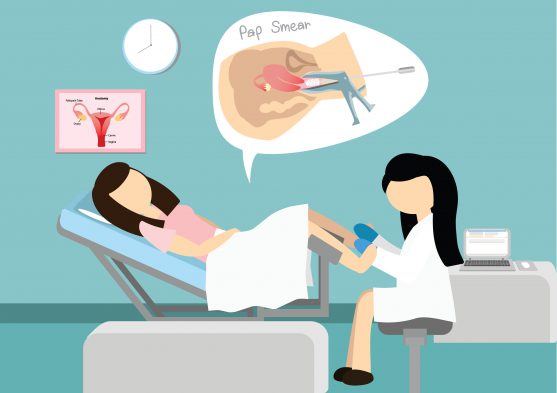Cervical cancer is one of the most preventable and treatable cancers. Despite that, every year more than half a million women are diagnosed with cervical cancer and over 3,00,000 deaths are reported globally.
According to recent research, cervical cancer ranks 8 th among all cancers and 4th among cancers in women globally.
Focusing on primary prevention and regular screening can help in early identification of precancerous changes, and is the best way to reduce the incidence of cervical cancer and its mortality.
According to studies, about 3 to 35% of early cancer-related deaths can be prevented through regular screening.

Types of cervical cancers
The cervix is a long, narrow, tubular-shaped organ located at the lower part of the uterus. It connects the uterus to the vagina.
Cervical cancer occurs when the normal cells lining the cervix undergo mutation and begin to grow uncontrollably.
Gradually, these abnormal cells may become invasive cancers and can spread to other parts of the body and can be fatal.
Based on the microscopic appearance of the cells, cervical cancer can be of the following types:
- Squamous cell carcinomas: Around 70 to 80% of cervical cancers are squamous cell carcinomas. This type of cancer develops in the thin, flat cells that cover the bottom of the cervix.
- Adenocarcinoma: It accounts for 20% of the cervical cancer cases. Adenocarcinoma begins in the glandular cells, which line the cervical canal.
- Mixed carcinomas: It has the characteristics of both squamous and glandular cancer cells. Mixed carcinomas or adenosquamous carcinomas are rare and account for only 5 to 6% of all cervical cancer cases.
Risk factors for cervical cancer
Most cervical cancers are caused by Human papillomavirus (HPV) infection.
HPV infection is a common, sexually transmitted disease that produces certain proteins, which may block the action of tumour suppressor genes, thus, allowing the growth and division of abnormal cells located in the lining of the cervix.
In addition to HPV, several other factors may increase the risk of cervical cancer. These include:
- Sexual history, including multiple sexual partners and sexual activity at a young age
- Smoking
- Weakened immune system
- Sexually transmitted diseases, such as chlamydia, gonorrhea, and syphilis
- Multiple full-term pregnancies
- Long-term use of oral contraceptives
- Family history of cervical cancer
Cervical cancer screening guidelines
Women who have a higher risk of cervical cancer must begin screening and follow-up testing as recommended:
Women between 21 to 29 years: Screening with Pap test is recommended every three years in women starting from the age of 21 until 29 years.
Women between 30 to 65 years: Women between the ages of 30 to 65 years have three options and the doctor may decide the best option for you.
- Pap test: Every three years if the test result is normal.
- An HPV test: Every five years if the test result is normal.
- Co-testing with an HPV test and a Pap test: Every five years with a Pap as well as HPV test if the test result is normal.
Women over the age of 65 years: Screening is not required if the previous screening results were normal for several years, or if the cervix is removed for non-cancerous conditions, such as fibroids.
Preparing for screening tests
- At least 48 hours prior to the test, you would be advised to avoid douching and using tampons, or vaginal medicines.
- These tests are not scheduled during your menstrual period.
- If there is any pre-existing cervicitis, it must be treated prior to the screening.
How are these tests performed?
- HPV testing: HPV test is recommended to women who have a higher risk of cervical cancer. In this test, a soft brush is inserted into the cervix to collect the samples of cervical cells. These cells are further examined in the laboratory to look for specific strains of HPV that are linked to cervical cancer. In most cases, a HPV test is combined with a Pap test.
- Pap testing: In this test, a tiny plastic spatula or a soft brush is inserted inside the cervix to collect a sample of cervical cells. These cells are further examined in the laboratory to look for any abnormalities.
What do the results indicate?
If the HPV or Pap test results are abnormal, certain follow-up tests may be advised to diagnose the cause.
In addition to the abnormal test result, if the woman experiences certain symptoms, such as abnormal vaginal bleeding, pain and bleeding during sexual intercourse, or heavy or longer menstrual bleeding then cervical cancer is suspected.
To confirm the diagnosis, you may be advised certain diagnostic tests, such as colposcopy, cervical biopsies.
Risks of screening tests
Cervical screening tests may have the following risks:
- Unnecessary follow-up: In young women, screening tests may indicate certain changes in the cervix, which may require additional tests to determine the possible cause.
- False-negative: In some cases, the test may show a normal result even if the cervical cancer is present. This may delay the diagnosis and timely treatment.
- False-positive: In some cases, these tests may suggest cancer even if the woman does not have it.
Despite these minor shortcomings screening for cervical cancer has been instrumental in reducing the incidence of cervical cancer worldwide. Women should be made aware of the risks and benefits of the screening tests, and encouraged to make informed decisions, so that cervical cancer can be prevented, and treated on time, if it occurs.


